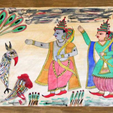Pinguli Chitragathi comes from the small and almost inconspicuous village of Pinguli, located near Kudal in Maharashtra, a home to the traditional folk arts of the Thakar Adivsi community from mid-18th century. Like the Bengal storytellers and their scroll paintings, Chitragathi is an innovative audio-visual medium, where the artist holds a hand-made paper painting depicting scenes from the epics. Every painting is accompanied with vivid narratives by the Chitrakar who modulates his voice to create drama and is backed by other vocalists and musical instruments.
Puppetry in Indian History
The ancient village of Pinguli in the Konkan region of Maharashtra has been home for nearly five hundred years of a wide variety of ritual performance arts. Due to the lack of support and the pressures of modernity in the region this invaluable heritage is in risk of disappearance. With the purpose of preserving the Adivasi artistic heritage, this trust is led by Shri Parshuram Vishram Gangavane. Gangavane has been working for more than thirty five years performing the traditional arts across India; and most recently with the opening of a Thakar Adivasi museum.
Traditional Thakar Arts:
- Kalsutri Bahulya: This folkloric form of string marionette theatre is accompanied by a local orchestra consisting of dholak, zanj, tuntune and singing. The marionettes’ heads and hands are carved in wood while the rest of the body is adorned with colorful clothes. The marionettes are manipulated from behind the stage by a single puppeteer who is also in charge of giving voice to the characters. The stories which are presented are taken from the epic of the Ramayana and Mahabharata.
- Dayti: The dayti is the Thakar Adivasi form of the shadow puppet theatre. The characters are built using goat skin and the characteristic style of the Pinguli painting school. As in the above mentioned art form, the stories are drawn from Ramayana and Mahabharata. The movements of the puppets, illuminated from behind the screen with an oil lamp, are accompanied by traditional music and the use of a shell to mark the entrance of the important characters.
- Chitrakathi: This is one of the few storytelling traditions alive in Maharashtra. With the help of paintings showing scenes of the ancient epics, the sutradhar unfolds the tale supported by the music of the vina, the taal and the huduk. It is in this type of performance that the stories of the Nandipuran are told showing the particular syncretism of Shiva and Vishnu religious paths.
Another eight ritual arts are present in their village including Radha Nritya, the Fugdya Folk Dance of the women, the Pangul Bael with the sacred bull and the Potraja where the dancer burns himself to take the evil away.
![]()
If you like this please Link Back to this article...



















0 comments:
Post a Comment
Note: Only a member of this blog may post a comment.